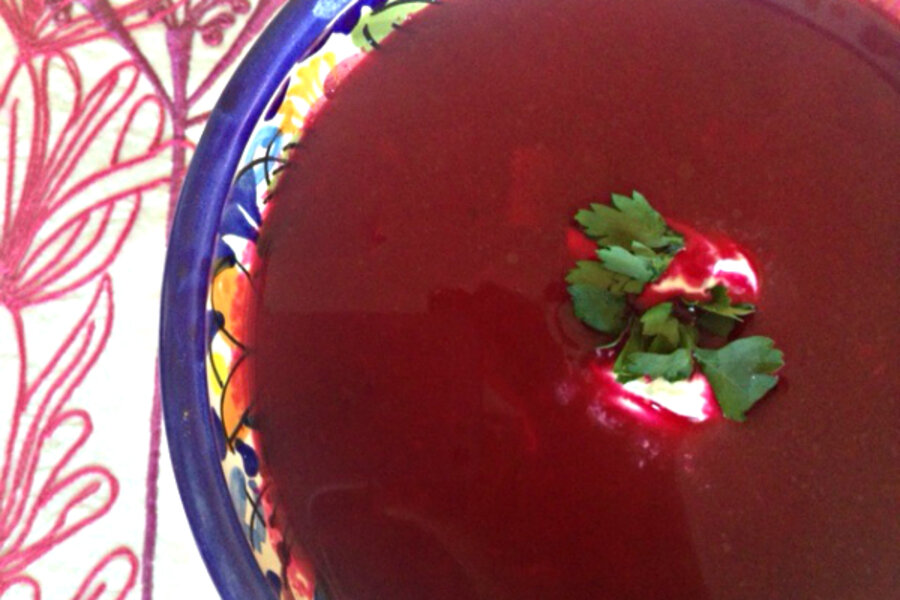Warm up your Olympic watching with a bowl of hot borscht
Loading...
Amid the medal count predictions, fears of terrorist attacks, and complaints of no hot water from the media hotels, you may have missed this fact from Sochi: Olympic officials estimate that 70,000 gallons of borscht (beet soup) will be served during the 2014 Winter Games.
The Monitor’s reporter at the Games, Mark Sappenfield, asked me via Twitter if I was planning to do a Russia-inspired food blog post. (Go follow Mark, @sappenfieldm, you’ll get his honest impressions from Sochi as he reports on his seventh Olympics and encounters things like a $100 laundry fee for a load that would fill half a basket.)
To be honest, my awareness of Russian food includes borscht and the unusual candy you can buy in Brookline, Mass., a Boston neighborhood populated by Russian immigrants. I had associated borscht with the vinegary, cold soups of summer. But I was pleased to discover that it can also be served cold or hot, with meat or without.
While it's enjoyed by many Slavic countries, Russia included, this simple soup made from stock, beets, potato, cabbage, and a variety of other vegetables, is considered the national dish of Ukraine. (Listen to a great interview about the history of the soup here, on NPR’s The Salt.)
I settled on a hot, vegetable version of borscht. If you swear you don’t like beets you should really reconsider, especially if you were raised with soggy canned beets. Fresh beets are delicious and sweet, and the potato in this soup gives it a really nice consistency and undertone. (Your teeth will not turn red, promise.)
Don’t toss out those beet greens! Simply chop them up, sauté with a little olive oil and garlic, and then season with a squeeze of fresh lemon, salt, and pepper. Serve as a side with your next meal.
This version of borscht comes out very red – shockingly red. If you are going for a color-themed dinner for Valentine’s Day later this week, start with a bowl of beet-red borscht.
Beet and cabbage borscht
From Bon Appétit
Serves 4 to 6
3 tablespoons olive oil
3/4 pound russet potatoes, peeled and chopped (about 1 large potato)
2-1/2 cups chopped green cabbage
1 large onion, chopped
8 cups vegetable broth
6 2-inch diameter beets, peeled and chopped (beet juice will stain everything!)
1 cup chopped tomatoes (drain, if using canned tomatoes)
1 tablespoon fresh lemon juice
Salt and pepper, to taste
To garnish:
Sour cream
Fresh parsley, chopped
1. Heat oil in a dutch oven or heavy, large pot over medium high heat.
2. Add potatoes, cabbage and onion, and sauté until cabbage softens, about 5 minutes.
3. Add broth, beets, and tomatoes. Bring to a boil, then reduce heat and simmer for 30 minutes, or until vegetables are tender.
4. With an immersion blender, blend until most of the vegetable chunks have been pureed. Or, working in small batches puree 4 cups of the soup in a blender, and then return to the pot.
5. Add lemon juice, season with salt and pepper.
6. Serve into bowls, garnish with a dollop of sour cream and chopped parsley.








